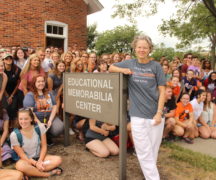By OFFICE OF MARKETING & COMMUNICATIONS
The Ohio Department of Higher Education recently approved $5 million in funding for projects that will enhance the quality of higher education throughout the state while making it more affordable for students by stabilizing or reducing tuition rates. Bowling Green State University received $750,000 for its PK-16 Pathways of Promise (P³) project.
P³ proposes to develop and field-test a scalable model for identifying key performance indicators of college-readiness in university data systems. The data is then shared with PK-12 partners, building a system for continuous program improvement for institutions of higher education and local education agencies.
Dawn Shinew, dean of the College of Education and Human Development, was excited to learn the project had been funded. “This project makes a lot of sense and has the potential to have a significant impact, not only for BGSU’s students, but for P-20 education in the state of Ohio.”
Shinew serves as a co-principal investigator on the project along with Dr. Brian Campbell, associate dean for Operations, Analytics and Assessment, and Dr. Matthew Lavery, assistant professor, School of Educational Foundations, Leadership and Policy.
The original pilot of the program began in summer 2016 after Shinew noticed a theme in conversations she had had with local superintendents – they didn’t have good data about how their students do in college. Shinew discovered that the data was available, it was just a matter of what could be pulled that was meaningful and respecting the students’ privacy. In June, data was shared with six local school districts: Bowling Green, Springfield, Fostoria, Otsego and Maumee and Toledo School for the Arts, with good feedback.
“The Bowling Green City Schools participated in the pilot data summit and found that the data was very relevant and informative to our administrative team,” Superintendent Francis Scruci wrote in a letter supporting the new project. “This project will no doubt have a positive impact on the college readiness of our students as they begin their undergraduate education.”
The P³ project continues the pilot model by including the University of Toledo and expanding to 11 school districts in year one and 20 local school districts by year two.
Data provided in the original project included performance on math and English placement tests, performance in selected benchmark courses, like biology, and first semester grade point averages. Shinew said that now that the award has been announced, the team will work with the University of Toledo to identify common data points useful to the local school districts.
“As superintendent of the Perrysburg School District, I appreciate the importance of sound data regarding the outcomes of our students,” Thomas Hosler wrote in support of the proposal. “[I] value the professional development opportunities such data presents for our administrators, teachers and staff members.”
Year two will include increased tracking of what school districts can do with this data to make sure their students are college ready. This could include professional development related to revisions in curriculum and/or instruction. Through increased college readiness, the program could also help to decrease the number of remedial/non-credit bearing courses, repeating courses with failing grades and the rate of students leaving colleges and universities because of an unsuccessful transition.
Andrew Sprang, the superintendent of Fostoria City Schools, commented on the impact in his letter of support for the expanded project: “This will provide us data to evaluate our programming and additional resources needed to help our students succeed in the future.”
Eventually, Shinew would like to see a model developed that could be scalable to the state, which would make Ohio the only state in the country with a systematic process for bridging the gap between local school districts and institutions of higher education.





